Germanwings crash: Co-pilot Lubitz 'hid illness'
- Published
Dusseldorf prosecutor: "Torn-up documents and sick notes support the assumption that the patient was hiding his illness"
The co-pilot suspected of deliberately crashing a Germanwings airliner into the French Alps hid details of an illness, German prosecutors say.
Torn-up sick notes were found in the homes of Andreas Lubitz, they say, including one for the day of the crash, which killed 150 passengers and crew.
A German hospital confirmed he had been a patient recently but denied reports he had been treated for depression.
The EU's aviation regulator has urged airlines to adopt new safety rules.
The European Aviation Safety Agency (EASA) said in future two crew members should be present in the cockpit at all times.
Data from the voice recorder suggests Mr Lubitz purposely started an eight-minute descent into the mountains after locking the pilot out of the flight deck.
There were no survivors when Flight 4U 9525 crashed in a remote mountain valley on Tuesday while en route from Barcelona in Spain to Duesseldorf in Germany.
Prosecutors say there was no evidence of a political or religious motive for his actions and no suicide note has been found.
French police say the search for passenger remains and debris on the mountain slopes could take another two weeks.
A memorial service is being held at a church in central Duesseldorf, attended by the mayor, Tomas Geisel.

At the scene: Anna Holligan, BBC News, Montabaur
Two officers stand watch at the end of a neat, suburban cul-de-sac. International TV crews focus their cameras on Andreas Lubitz's family home. The blinds are down. A candle has been placed on his parents manicured lawn, with an image of hands clasped in prayer.
Neighbours describe him as a "quiet, affable man". They are struggling to accept that the 27-year-old they once knew could be capable of committing mass murder.
Investigators carrying boxes of evidence and a computer have come and gone. With the discovery of a discarded sick note in his Duesseldorf apartment and confirmation that he attended a medical clinic just days before the crash, the suggestion is that this quiet man was hiding something.
That secret may eventually reveal why he took not just his own life but the lives of 149 others.

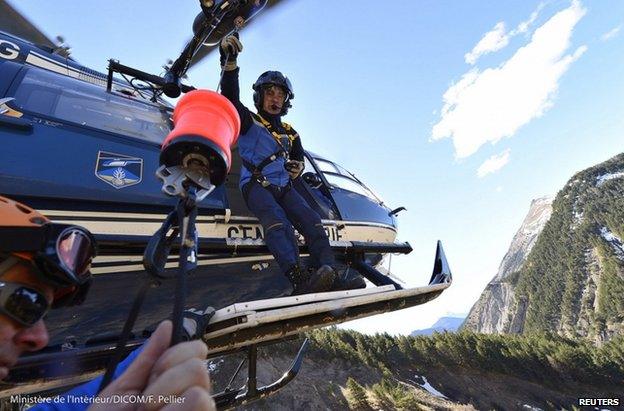
Searchers are being ferried to the crash site by helicopter
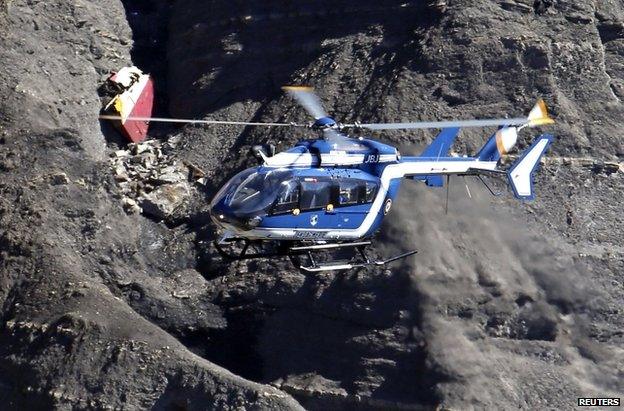
Investigators face a formidable task in the mountains
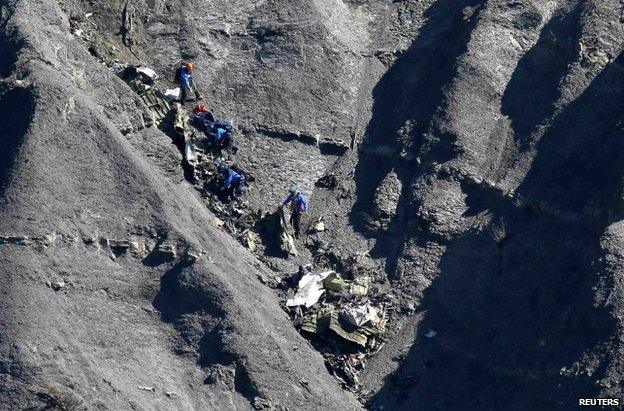
Police say little of the plane remains intact
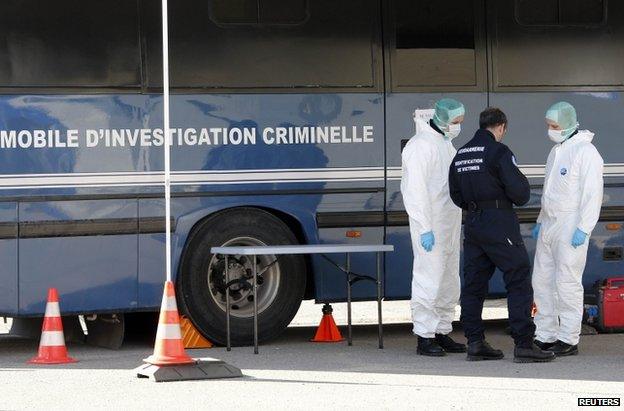
French forensic scientists are examining body parts from the crash site
In a statement, external (in German), prosecutors said they had seized medical documents from Mr Lubitz's two residences - his Duesseldorf flat and his parents' home north of Frankfurt - which indicated an "existing illness and appropriate medical treatment".
The "fact that, among the documents found, there were sick notes - torn-up, current and for the day of the crash - leads to the provisional assessment that the deceased was hiding his illness from his employer", the report states.
Germanwings confirmed it had not been given a sick note for the day of the crash.
Duesseldorf's University Hospital issued a statement, external (in German) saying Mr Lubitz had attended the hospital on 10 March and last month.
Adding that it had handed his medical records over to prosecutors, it said reports the co-pilot had been treated there for depression were incorrect.
Germany's Rheinischer Post newspaper, which spoke to the hospital, quoted its own unnamed sources as saying Mr Lubitz had been suffering from a physical, rather than a mental, illness.

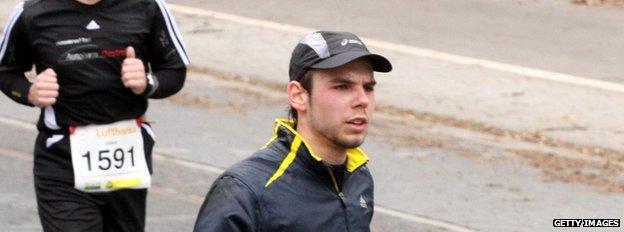
Andreas Lubitz running a half-marathon in Frankfurt in March 2010
Lubitz's health timeline
2009: Breaks off pilot training while still in his early twenties after suffering "depressions and anxiety attacks", the German tabloid Bild reports, quoting Lufthansa medical files. Resumes training after 18 months of treatment, according to Bild
2013: Qualifies "with flying colours" as pilot, according to Lufthansa
2013-2015: Medical file quoted by Bild marks him as requiring "specific regular medical examination" but no details are given
February 2015: Undergoes diagnosis at Duesseldorf University Clinic for an unspecified illness; clinic has clarified the illness was not depression
10 March 2015: Again attends Duesseldorf University Clinic
24 March 2015:Is believed to have deliberately crashed airliner, killing himself and 149 others
26 March 2015: Prosecutors announce that two sick notes have been found torn up at his addresses in Germany

The theory that a mental illness such as depression had affected the co-pilot was suggested by German media, quoting internal aviation authority documents.
They said he had suffered a serious depressive episode while training in 2009.
He reportedly went on to receive treatment for a year and a half and was recommended regular psychological assessment.
Mr Lubitz's employers insisted that he had only been allowed to resume training after his suitability was "re-established".

Police have been coming and going at the home of Mr Lubitz's parents north of Frankfurt, which is also a focus of intense media attention
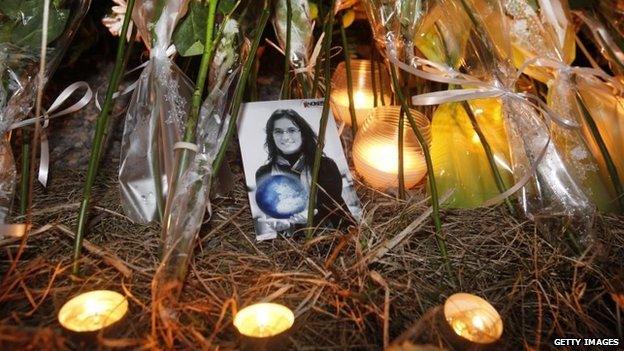
In the hamlet of Le Vernet, a "viewing tent" was set up where families could look in the direction of the crash site. Families laid flowers and photographs in memory of those lost
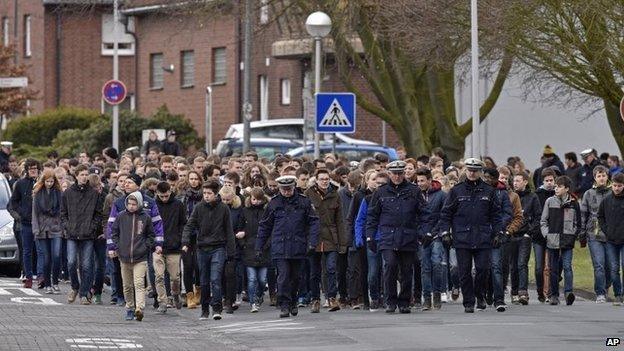
School students in Haltern, Germany, attended a memorial service for 16 students and two teachers who died in the crash on their way home from a study exchange
'Rule of two'
Speaking just before the EASA issued its advice, Lufthansa announced it would adopt the "rule of two" as soon as possible.
Family members of some of the passengers and crew who died have visited Seyne-les-Alpes, near the crash site.
DNA samples are being provided to allow for identification of victims' remains.
The plane's second "black box", which records flight data, has yet to be found.
"There's not much plane debris left," police spokesman Xavier Vialenc was quoted by AFP news agency as saying. "There's mainly a lot of body parts to pick up."

Other incidents thought to be caused by deliberate pilot action
29 November 2013: A flight between Mozambique and Angola crashed in Namibia, killing 33 people. Initial investigation results suggested the accident was deliberately carried out by the captain shortly after the first officer (also known as the co-pilot) had left the flight deck.
31 October 1999: An EgyptAir Boeing 767 went into a rapid descent 30 minutes after taking off from New York, killing 217 people. An investigation suggested that the crash was caused deliberately by the relief first officer but the evidence was not conclusive.
19 December 1997: More than 100 people were killed when a Boeing 737 travelling from Indonesia to Singapore crashed. The pilot - suffering from "multiple work-related difficulties" - was suspected of switching off the flight recorders and intentionally putting the plane into a dive.
Source: Aviation Safety Network
